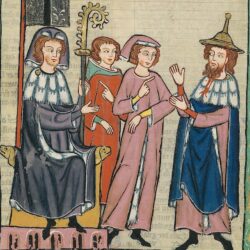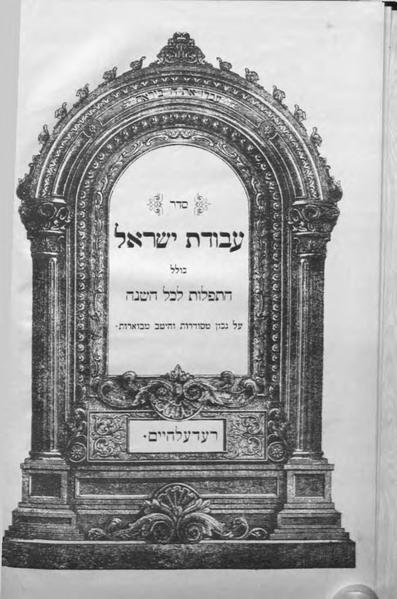The Hagada has hitherto been considered the piece, par excellence, common to all the liturgies, and bearing the least and fewest marks of national differentiation. The examination of our MS. shows, however, that this part of the Service reflects as clearly and unmistakably the characteristic independence of the English liturgy, already noted in a previous article, as the rest of the prayers. Notwithstanding its small bulk, several variations distinguish and mark it off from the French ritual. Thus, for example, the repetition, in the vernacular, of the first two pieces, before and after the second cup—which, we learn from Rashi’s Pardess was the French usage—was not customary in England.[1] Solomon b. Jehuda, the saint of Dreuæ (see Gross, Revue des Études Juives, XIII, 46, No. 3), followed this custom of translating the Hagada into the vernacular, so Samuel of Falaise reports, as quoted by R. Isaac, Or Sarua, 119a והקדוש מדרי׳׳וש היה רגיל לומר בלע׳ז עד כולנו מסובין. Had it been so, how valuable would the English renderings from the pre-expulsion period have been to us. Or, perhaps, they too would have been in French. The single non-Hebraic term which R. Jacob gives in his Ritual of the Seder, cerfeuil, the name of the vegetable handed round after the first cup, is French, and is met with in authorities of French origin or descriptive of the French ritual, e.g., in the Machzor Vitry (ed. Hurwitz, p. 294: ויקח מן הצרפוייל).
In the third part of his Hilchot Pesach, R. Jacob gives detailed instructions for the preparation of charoseth. But we look in vain in his work for a translation of the term, though such is given in Zidkiah b. Abraham’s שבלי הלקט (ed. S. Buber, p. 184).
The directions for the preparation of the mixture are as follows:—
We need but compare this with Zidkiah b. Abraham’s recipe, to notice the difference of national usage, even in this trifling detail. In England, all the fruits named in the Song of Songs—dates, figs, pomegranates, nuts and apples—were crushed with almonds and moistened with vinegar. In Italy, spices, vegetables, blossoms, and even a sprinkling of lime formed some of the ingredients of the paste. R. Moses of London, quoted in this connection, appears here as an unquestioned authority for the Seder ritual. For the first time, an English Rabbi, a master in Halacha and an authority in traditions, confronts us as a living personality and not merely a nominis umbra. R. Moses’ decisions were recognised even when opposed to the pronouncements of such great French teachers as the famous R. Isaac b. Abraham=Isaac of Dampierre, brother of R. Simson of Sens, who, by the way, was known in England by the abbreviation ריברא, not ריבא or ריצבא. As in France, they relied for their knowledge of the Seder ceremonies on such revered teachers as R. Solomon b. Isaac of Troyes, R. Joseph Tob Elem and others, who worked out arrangements of the Seder ritual, in prose and verse; so R. Moses of London stood out as the central authority in tradition for the whole of England. Most probably he also left a compilation of the rules appertaining to this service, which Jacob b. Judah possessed in manuscript, just as he left compilations of other ritual laws, e.g.:— הלכות מליחת בשר וכל הדינים כאשר סדרם רבינו מלונדרושא ת׳נ׳ב׳ה (Bodleian Library, codex 882).
But apart from the historical interest of R. Jacob’s Agada, it deserves examination for its deviations from, and additions to, the textus receptus. In the following pages I have carefully copied the rubrics which precede the Agada and are interspersed in it; and also noted all the essential variants of the Agadah as contained in the fourth part of the 26th Book of the Etz Chaim. Thus an idea may be formed of the text of the Agada which, three years before the expulsion, was already accepted by the English Jews as a heirloom of the past:—
After the formula כהא לחמא, which corresponds completely with the ordinary reading, the direction follows:—
The form of the questions exhibits no difference whatever, except that אנחנו is used throughout instead of אנו.
In the opening of the response עבדים היינו we read:—
כלנו זקנים ; ובזרוע נטויה ובאותות ובמופתים ובמורא גדול
[9] L. Hoffmann in Berliner’s Magazin13,193, note 1. is wanting; מצוה לספר alone is found.
The passage concerning the night spent in Bené Brak, which is only known from the Agada—its original source being still undiscovered—arranges the names in the following order:— מעשה ב֗ר֗ אליעז֗ בן עזריה ור֗ אלע֗ ורבי יהושע ור֗ עקיבא ור֗ טרפון. It only reads כל הלילה.
The formula ברוך המקום is peculiar and against Reifmann’s hypothesis, that this piece is of the nature of a responsorial song. It begins as follows:— ברוך המקום ברוך הוא ברו׳ שמו ברוך הוא שנתן תורה לעמו ישר׳ כנגד ארבעה…….
The wise son says, in contradistinction to his wicked counterpart:— אשר צוה יי’ אלהינו אותנו ואפ, as, indeed the Mechilta and all ancient texts of the Agada read (comp. Hoffmann in Berliner’s Magazin, 13,193). The speech put into the mouth of the רשע has the readings:— שאילו היה שם ,שהוציא עצמו. In the fourth son’s speech לאמר is omitted.
The piece יכול contains the reading:— לא אמרתי לך.
After ברוך שומר it is said:— ב״ה ב׳׳ש שהק֗ חשב לגלות הקץ כמה שאמ׳.
In צא ולמד the reading is מלמד שלא ירד להשתקע ,לעקור הכל שם אלא לגור שם כי כבד הרעב is wanting,— גדול ועצום שנ׳ וירעו עבודה קשה and וישימו עליו שרי מסים are omitted,
After the words אני הוא ולא אחר, a passage follows which has hitherto been regarded as specially and exclusively interpolated in the Provençal Ritual. Here it boldly appears in the text without the suspicion of a hint that it was condemned by some authorities. Juda Halevi (Kusari, III., 73), who sought it in vain in the Talmud, i.e., the ancient authorities, correctly recognised it as a poetical elaboration of the conception that the Exodus was God’s own direct and immediate work. That the piece did not belong to the Spanish Ritual is proved by his remark that it is only found in one ritual—as we now know—the Provençal. If the author of Amfoth (Gross in Berliner’s Magazin X., 64) was correctly informed, this piece and its recitation at this portion of the service were condemned by the Rabbis of Palestine (see Luzzatto in Polak’s הליכות קדם, page 41). Mr. Schechter has already pointed out (Jewish Quarterly Review, IV., p. 255) that R. Judah b. Jakar also failed to discover the source of this Agada. The English reading of the passage is undoubtedly more correct than that given in Machzor Vitry, p. 293:[10] The objection to this deduction in Machzor Vitry, p. 293, is corrupt. Instead of ואותו כקל וחומר, left by Hurwitz uncorrected, we should read ואותו קל וחומר האמור והלא עבדיו מקיפין אותו כדי שלא ימצא צער ……בגופו ואתה מלך בו, [מופרך הוא] אטו מי ; comp. הליכות קדם, p. 41. —
In the following passage the reading is:— זו החרב שנ׳, דבר אחר ביד חזקה ובזרוע נטועה שתים ובאתת ,זו נלד שכינה של ,מהו או׳ ,מנין שלקו המצריים ,שתים ובמורא נתל שתים ובמפתים שתים אמור מעתה ,ואל הים מהו או ,אצבע אלהים הוא זה is wanting.
For הקדוש ברוך הוא, the reading throughout is ‘הק.
In כמה מעלות the single variant is לנו ממונם.
In עלינו ,אל אחת is wanting after למקום. The reading is:— לחרבה ,ועשה בהם שפמי׳ ובאלהיהם.
The piece commencing ר’ גמליאל varies:— שלשה ,ר׳ל או׳ בזמן שבית המקדש קים ,אלו הן ,דברים הללו is wanting.
במצרים ,על שום שפסח המקום על בתי בני ישר׳ שנ׳ before בנגפו is wanting.
עד שיגלה ,בצקת אבותינו ,ויקח מצה ויאמ׳.
את כל עברתם ,המצריים חיי ,ויק֨ח ה֨מרור ו֨יאמ׳ is wanting; לראות עצמו כאלו יצא :
ולברך ,חייבין ,ויגבי֨ה כ֨ל אח֨ד כוס֨ו יא֨מ׳ : לפיכך is wanting.
ומאפלה לאור גדול ומאבל לי״ט ,שעשה נסים לאבותינו is wanting.
Against the tradition in Ibn Jarchi (המנהיג, Pesach, p. 75), the conclusion here reads:— ונאמר לפניו שיר חדש הללויה.
Before the recitation of the Hallel, which, in spite of its being unabbreviated, appears without the customary introductory blessing, the remark is made:—
After למעינו מים, the direction is given ואומ׳ בע֨ל הבי֨ת. In the blessing מן הפסחים ומן הזבחים לכשיגיע ,והגיענו הלילה הזה.
Here follow the rules for the blessings to be recited before the meal:—
The curious passage שפוך חמתך, which appears immediately after Grace and before the continuation of the Hallel, and has become associated with Elijah’s Cup, but for which there is no authority in the ancient Talmudical literature, was recited in the following characteristic form:
While, therefore, the Italian Jews recited only Ps. 59:6 (cp. Roman Machzor), and the Sephardic Jews added v. 7, and the present form has in addition Lam. 3:66, we see here, in contradistinction even to the North-French Ritual, as preserved in Machzor Vitry, p. 296, with its many verses, the following independent selection of Scriptural texts: Psalm 69:6, 7, 28; Lam. 3:64-66; Ps. 69:26, 29; Ps. 2:9 ; Hosea 9:14; Jer. 10:25. The margin contains, in addition, Ps. 35:5, 6; Jer. 17:18; Ps. 37:15; Ps. 69: 24; Ps. 83:18, in the same hand as the text:—
Then follows the rubric:—
Before מן המצר the direction is given:— ויע֨נו המסוב֨י׳ הודו בכל פסוק, and before מיכאן ואילך כופל—אבן מאסו.
Before יהללוך the remark is made:—
The conclusion here reads:—
Then comes the following passage:—
The conclusion consists of the brief memoria technica of the Seder Ritual. A commentary on it is not given, though the writer probably composed one; just like Samuel b. Solomon, styled Sir Morel of Falaise, who wrote one on Joseph Tob Elem’s rhymed Pesach arrangement which is preserved by R. Isaac, Or Saruah (II. 114-20); or, to quote a later instance, Solomon b. Jechiel Luria, who provided a Commentary to his own verses on this theme, in which he gives his name acrostically (Resp. 88):—
קדוש נטול מור / עובר לכחוש לחמי / [צרפויל .s]
נסי גאל ידך תינא סמוך עני | ארר
חזיר זכרו סועד שבור שוטמי
מי פרנסה תן כוס מעריץ קוני:
Then follow rules for those who perform the Seder in other households:—
Of free poetical additions, which certainly embellished the Seder Evening Service in Anglo-Jewish, as in French and Italian homes, the author of our compendium has preserved only one specimen in his work. Before passing on to the chapter on the Middle Days of the Festivals, he gives the piece כי לו נאה כי לו יאה. Zunz says (Gottesdienstl. Vort., 2nd edition, p. 133) that it, together with the last three passages of the Agada, was added in the 10th century. But, at the close of the 13th century, we see it a firmly established portion of the English Ritual, before the expulsion. The author of the Etz Chaim has even taken care to anticipate all questions as to its antiquity, by adding a stanza in which he introduces his own name, Jacob, acrostically. There can be no doubt, therefore, that in his time already this poetical effusion formed an integral portion of the Seder Ritual. Its original form is that given here. In our Ritual and in the Roman it has suffered several modifications. It may fitly form the pendant to this note:—
אדיר במלוכ׳ • ברוך כהלכה • גדודיו יאמרו לו לך ולך לך כי לך לך אף לך לך יי הממלכה • כי לו נאה כו׳
דגול במלוכה הדור כהלכה • ותיקיו יאמרו לו לך ולך כו׳ כי לו נאה כו׳ :
זכאי במלוכה חסין כהלכה • טפסריו יאמרו לו לך ולך כו׳ כי לו נאה כו׳ :
יחיד במלוכה מרום כהלכה • נוראיו יאמרו לו לך ולך כו׳ כי לו נאה כו’ :
סביב במלוכה עניו כהלכה • פדוייו יאמרו לו לך ולך כו׳ כי לו נאה כו׳ :
צדיק במלוכה קדוש כהלכה • רחומיו יאמרו לו לך ולך כו׳ כי לו נאה כו׳ :
שתול במלוכה תקיף כהלכה • י֨קיריו יאמרו לו לך ולך כר כי לו נאה כו׳ :
ע֨זוז במלוכה ק֨נוא כהלכה • ב֨ניו יאמרו לו לך ולך לך כי לך לך אף לך לך יי הממלכה :
Dávid Kaufmann. “The Ritual of the Seder and the Agada of the English Jews before the Expulsion.” The Jewish Quarterly Review, Vol. 4, No. 4 (Jul., 1892), pp. 550-561. We are grateful to the University of Pennsylvania Press and Center for Advanced Judaic Studies, University of Pennsylvania for making access to this Public Domain work available. Transcription and preparation by Aharon Varady — Shgiyot mi yavin, Ministarot Nakeni שְׁגִיאוֹת מִי־יָבִין; מִנִּסְתָּרוֹת נַקֵּנִי “Who can know all one’s flaws? From hidden errors, correct me” (Psalms 19:13).
In honor of Pesaḥ this year, I’ve transcribed “The Ritual of the Seder and the Agada of the English Jews before the Expulsion” by Dr. Dávid Kaufmann (1852-1899) which first appeared in The Jewish Quarterly Review, Vol. 4, No. 4 (Jul., 1892), pp. 550-561. In the article, Kaufmann describes an English Haggadah contained in an extremely rare manuscript, the Etz Ḥaim by R’ Jacob b. Jehuda of London, a singular witness to the English liturgical tradition prior to King Edward I’s Edict of Expulsion in 1290. In this and another article on the Etz Ḥaim, Kaufmann clearly hopes the manuscript will be published and more widely accessible to scholars. Preserved in a German library before the Shoah, we are not certain where this manuscript is preserved today (if it survived the war). If you know it’s wherabouts please share your knowledge, and if you would like to help translate this work in reconstructing what an English Haggadah might have read like in the 13th century, please share your work.
Notes
| 1 | Solomon b. Jehuda, the saint of Dreuæ (see Gross, Revue des Études Juives, XIII, 46, No. 3), followed this custom of translating the Hagada into the vernacular, so Samuel of Falaise reports, as quoted by R. Isaac, Or Sarua, 119a והקדוש מדרי׳׳וש היה רגיל לומר בלע׳ז עד כולנו מסובין. |
|---|---|
| 2 | Or Sarua, II., 119b. |
| 3 | מחזור ויטרי, ed. Hurwitz, p. 274, note א. |
| 4 | Ib., p. 278. |
| 5 | Pesachim, 114b; Machzor Vitry p. 284. |
| 6 | Ibn Jarchi, המנהיג Pesach, § 69. |
| 7 | Machzor Vitry, p. 272 |
| 8 | Ib., p. 271, note א. |
| 9 | L. Hoffmann in Berliner’s Magazin13,193, note 1. |
| 10 | The objection to this deduction in Machzor Vitry, p. 293, is corrupt. Instead of ואותו כקל וחומר, left by Hurwitz uncorrected, we should read ואותו קל וחומר האמור והלא עבדיו מקיפין אותו כדי שלא ימצא צער ……בגופו ואתה מלך בו, [מופרך הוא] אטו מי ; comp. הליכות קדם, p. 41. |
| 11 | שבלי חלקט, .ed. Buber, p .ק |
| 12 | Pesachim, f. 116b. |
| 13 | שבלי הלקט, ib.; המנהיג, Pesach, § 67. |
| 14 | המנהיג, Pesach, § 82. |
| 15 | Ib., §. 79. and Pesachim, f. 116a. |
| 16 | What is here related in the name of R. Menachem, the saint of Joigny, Isaac, Or Sarua (II., 119b), tells in the name of R. Jom Tob of Joigny, the martyr of York. See Z. Cahn, Revue des Études Juives, III. 4. |
| 17 | המנהיג, Pesach. § 86. |
| 18 | Pesachim. f. 102b. |
| 19 | Arachin, f. 10a (Tosafot, s. v. י״ח). Cf. Berachot, f. 14a, Tosafot, s. v. ובלילי פסחים יש שמברכין פעמיס ובתחלה לקרות ואחר הסעודה אחר שפוך מברכין לגמור. |
| 20 | Tosafot Pesachim, f. 118a, s. v. רבי יוחנן. |
| 21 | G. Bikell, Messe u. Pascha, p. 81, thinks that the fifth cup is first mentioned in the 10th century. He has overlooked the fact that in the Boraitha Pesachim, 118a, the old reading is כוס חמשי. See Siddur Rav Amram I., שבלי הלקט. מיא, p. 200; Joseph Caro. Tur Orach Chaim. 481. |

“📄 הגדה לסדר פסח | The Ritual of the Seder and the Agada of the English Jews Before the Expulsion (1287)” is shared through the Open Siddur Project with a Creative Commons Public Domain Dedication 1.0 Universal license.








Thanks to a reference found in Richard Sarrason’s “The Persistence and Trajectories of Penitential Prayer in Rabbinic Judaism,” I found that the Eits Ḥayyim by Jacob b. Jehudah Hazan of London can be found was reprinted in the 1960s and published in three volumes (ed. Israel Brodie; 3 vols.; Jerusalem: Mossad Harav Kook, 1962-67).